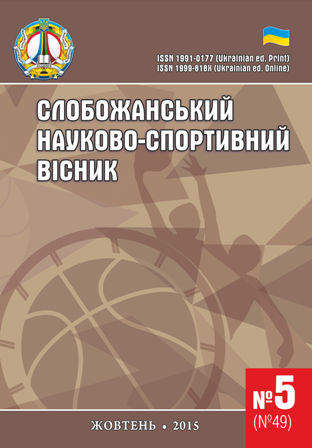Features power ectomorphs athletes are engaged in bodybuilding in transition training
DOI:
https://doi.org/10.15391/snsv.2015-5.005Keywords:
features of the diet, athletes ectomorphs, training process, transition, optimal diet microcycleAbstract
Purpose: to develop and study the diet of athletes engaged in bodybuilding ectomorphs in transition training considering the restoration of lean body mass and functional state of an athlete Material and Methods: the study involved 18 athletes engaged in bodybuilding ectomorphs included in the national team in the Kharkiv region bodybuilding. Methods were used: the theoretical method and summarize the literature, pedagogical supervision, pedagogical experiment, methods of mathematical statistics. Results: comparative characteristics of the diet have been developed for athletes ectomorphs engaged on bodybuilding to increase muscle weight. It was divided the athletes into two experimental groups: the first EG used a balanced diet that made protein 2 grams per 1 kilogram of body weight and carbohydrates 4–5 g·kg–1 in the second EG was protein 3 grams per 1 kilogram of body weight, and carbohydrate 6 grams kg. Second EG diet consists of 6 single meal and is about 2800–3500 calories per day. Conclusions: on the basis of research by the author offered the optimal diet for athletes ektomorfiv second experimental group engaged in bodybuilding.
References
Borisova O. O. Pitaniye sportsmenov: zarubezhnyy opyt i prakticheskiye rekomendatsii [Sports Nutrition: international experience and best practices], Moscow, 2007, 132 p. (rus)
Golberg N. D., Dondukovskaya R. R. Pitaniye yunykh sportsmenov [Meals young athletes], Moscow, 2007, 240 p. (rus)
Dzhim V. Yu. Slobozans’kij nauk.-sport. visn. [Slobozhanskyi science and sport bulletin], Kharkіv, 2013, vol. 4 (37), p. 15–19. (ukr)
Dzhim V. Yu. Slobozans’kij nauk.-sport. visn. [Slobozhanskyi science and sport bulletin], Kharkіv, 2014, vol.6 (44), p. 34–40. (ukr)
Dzhim V. Yu. Naukoviy chasopis natsіonalnogo pedagogіchnogo unіversitetu іmenі M. P. Dragomanova [Science magazine National Pedagogical University M.P.Dragomanov], Kiіv, 2014, vol. 12 (53) 14, p. 36–40. (rus)
Druz V. A., Dorofeyeva T. I., Dzhim V. Yu., Pugach Ya. I. Vliyaniye emotsionalnogo sostoyaniya na vypolneniye dvigatelnoy deyatelnosti v ekstremalnykh usloviyakh yeye protekaniya [Influence of emotional state to perform motor activities in extreme conditions of its occurrence], Kharkov, 2014, 305 p. (rus)
Druz V. A., Buren N. V., Pyatisotskaya S. S., Dzhim V. Yu., Zhernovnikova Ya. V., Zadorozhnaya E. A., Pugach Ya. I. Obzornyy analiz po probleme «Teoretiko-metodologicheskiye osnovy postroyeniya sistemy massovogo kontrolya i otsenki urovnya fizicheskogo razvitiya i sostoyaniya fizicheskoy podgotovlennosti razlichnykh grupp naseleniya» [Survey analysis on the problem of "Theoretical and methodological bases of construction of system of mass control and assess the level of physical development and physical readiness of various groups of the population"], Kharkov, 2014, 127 p. (rus)
Sheyko B. I. Pauerlifting : nastolnaya kniga trenera [Powerlifting: Handbook trainer], Moskva, 2003, 532 p. (rus)
Oleshko V. G. Silovyye vidy sporta [Power Sports], Kyiv, 1999, 287 p. (rus)
Platonov V. N. Sistema podgotovki sportsmenov v olimpiyskom sporte. Obshchaya teorіya i yeye prakticheskiye prilozheniya [The system of training athletes in Olympic sports. Total teorіya and its practical application], Kiyev, 2004, 808 p. (rus)
Vinogradov G. P., Gazimov R. R., Stepanov V. S., Shabanov A. I. Novyy metod trenirovki v bodibildinge [A new method of training in bodybuilding], Saint Petersburg, 1997, 79 p. (rus)
Dzho Uayder. Sistema stroitelstva tela [System construction body], Moskva, 1991, 112 p. (rus)
Veyder B., Veyder D. Klassicheskiy bodibilding: sovremennyy podkhod «Sistema Veyderov» [Classic bodybuilding: a modern approach "system Vader"], Moscow, 2003, 432 p. (rus)
Konnors E., Grimkovski P., Kimber T., Mak-Kormik M. Bodibilding : balans krasoty i zdorovya [Bodybuilding: a balance of beauty and health], Moscow, 2000, 174 p. (rus)
Kleiner S. M. Nutrional status of nationally ranked elite bodybuilders / S. M. Kleiner, T. L. Bazzarre, B. E. Ainsworth // International Journal of Sport Nutrition. – 1994. – № 4. – P. 54–69.
Cornelius A. E. Applications of multilevel modeling in sport injury rehabilitation research / A. E. Cornelius, B. B. W.rewer, J. L. Van Raalte // International Journal of Sport and Exercise Psychology. – 2007. – vol. 5(4). – pp. 387–405. – doi:10.1080/1612197X.2007.9671843.
Visek A. J. Athletic identity and aggressiveness: A cross-cultural analysis of the athletic identity maintenance model / A. J. Visek, J. C. Watson, J. R. Hurst, J. P. Maxwell, B. S. Harris // International Journal of Sport and Exercise Psychology. – 2010. – vol. 8(2). – pp. 99–116. – doi:10.1080/1612197X.2010.9671936.
Downloads
Published
How to Cite
Issue
Section
License
Copyright (c) 2015 (Viktor Dzhym) Джим Віктор Юрійович

This work is licensed under a Creative Commons Attribution 4.0 International License.
Our publications make use of copyright CREATIVE COMMONS open access journals.
Authors published in this journal agree to the following terms:
1 The authors reserve the right of authorship of the work and pass the journal right of first publication of this work are licensed under the Creative Commons Attribution License, which allows others to freely distribute the published work with reference to the authors of the original work and the first publication of this magazine.
2 The authors have the right to enter into separate agreements for additional non-exclusive distribution of work in the form in which it was published the magazine (such as work place electronic repository institution or publish as part of the monograph), provided that the reference to the first publication of this magazine.

 Attention, authors!
Attention, authors!


